Bulk Process Equipment, Bulk Solid Material Processing & Handling Equipment, Industrial Bulk Solids Material Handling Systems
|
Material Handling & Processing Equipment |
About Us | Material Handling Equipment | Solid Material Processing | Plant Services | Manufacturers | Equipment Photos | Clients | Case Studies | News | Contact Us | Home
Case Studies: Bulk Material Handling Equipment & Systems
Success Stories for I-2/BPST Customers
Case Study 1 • Case Study 2 • Case Study 3 • Case Study 4 • Case Study 5 • Case Study 6
Case Study 7 • Case Study 8 • Case Study 9 • Case Study 10
Case Study 1
I-2/BPST Successfully Starts Up A Blending, Conveying & Packaging Systems
for Sweetener Plant in Brooklyn, NY
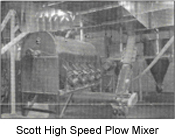 Real estate prices are very high in NY City. When this sweetener manufacturer decided to consolidate their manufacturing under a single roof in Brooklyn, it presented a challenge to fit all of the equipment in the available space. However, Mr. John Frederick, of 1-2/BPST, offered a solution that includes High-Speed plow Mixers from Scott Equipment, specialized Flexible Screw Conveyors, custom Bulk Bag Dischargers, Screw Conveyors from Thomas Conveyor in 0 compact lay-out designed to solve this problem.
Real estate prices are very high in NY City. When this sweetener manufacturer decided to consolidate their manufacturing under a single roof in Brooklyn, it presented a challenge to fit all of the equipment in the available space. However, Mr. John Frederick, of 1-2/BPST, offered a solution that includes High-Speed plow Mixers from Scott Equipment, specialized Flexible Screw Conveyors, custom Bulk Bag Dischargers, Screw Conveyors from Thomas Conveyor in 0 compact lay-out designed to solve this problem.
Case Study 2
Scott Equipment Provides Turnkey Drying System To Convert Nasoya Tofu Waste Into An Organic Animal Feed Product
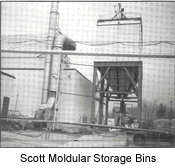 Nasoya Foods is a Massachusetts producer of tofu. Due to heavy demand for their product, Nasoya was faced with an increasing problem of disposal of their soybean waste.
Nasoya Foods is a Massachusetts producer of tofu. Due to heavy demand for their product, Nasoya was faced with an increasing problem of disposal of their soybean waste.
In the past they paid local farmers to haul and use the waste as fertilizer. But due to new environmental laws and strict township regulations, Nasoya had to come up with a new way to dispose of their waste in order to get plant expansion permits.
Gary Datta, an engineer at 1-2/BPST, met with Nasoya management and proposed to solve this problem by drying the waste into a high protein organic product.
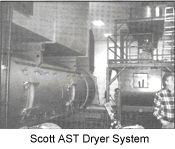 John Wareham and Dan Macphail, the management team of Nasoya, being aware of the high protein content in soybean waste, investigated and found that there was a high market demand for dried soy waste. Scott Equipment, in collaboration with 1-2/BPST, offered a turn key AST Dryer System to dry 13,500 Lbs/Hr soybean and tofu waste, from an average 60% moisture content to a dry product at minus 10% moisture. The system included a Scott Dryer, Cooler, Mixer, Silo System and a Pneumatic Conveying System.
John Wareham and Dan Macphail, the management team of Nasoya, being aware of the high protein content in soybean waste, investigated and found that there was a high market demand for dried soy waste. Scott Equipment, in collaboration with 1-2/BPST, offered a turn key AST Dryer System to dry 13,500 Lbs/Hr soybean and tofu waste, from an average 60% moisture content to a dry product at minus 10% moisture. The system included a Scott Dryer, Cooler, Mixer, Silo System and a Pneumatic Conveying System.
The project was completed successfully in the first quarter of 2002. At present, the plant converts 1 0,500Ibs/hr of tofu waste into 4,000Ibs/hr high protein product. Profit from the sale of the dry product will pay for the new plant in less than two years. Both 1-2/BPST & Scott Equipment provided a profitable solution for Nasoya Foods by converting their waste into a self-sufficient, high value product.
Case Study 3
New Fluid Bed Dryer Increase Productivity by 50% While Saving $60,000 Per Year In Maintenance (Processing Magazine, Feb. 7, 2004)
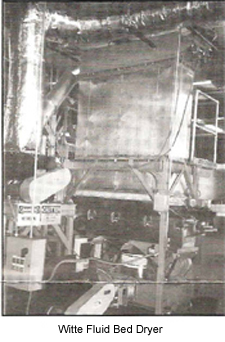 No one could determine precisely why the mysterious goo was forming on their dryer but the operators at Complete Spill Solutions, Watertown, New York, had had enough of trying to remove the sticky sap-like goo that was blinding its screens and CEO Geoff Perry was growing increasingly concerned about its impact on productivity. Drying up to 75% moisture recovered fibers from the waste stream of a paper mill, Mr. Perry had targeted production rates of 2,000 lbs./hr. but the design of the round fluid bed dryer hampered his efforts. “This ‘goo’ was a horrendous problem,” says Mr. Perry. “We had to shut down the entire line once per month to clean the dryer, which was a major undertaking. In labor costs and lost production alone, this cost about $5,000.00 every month.” The dryer’s sintered screen design was prone to warping that created peaks, valleys and dead spaces where the gooey residue would form, gather and clog. This blinding prevented efficient airflow and caused severe drops in productivity. “It would get progressively worse until the product came out wet and we had no choice but to shut down,” adds Mr.
No one could determine precisely why the mysterious goo was forming on their dryer but the operators at Complete Spill Solutions, Watertown, New York, had had enough of trying to remove the sticky sap-like goo that was blinding its screens and CEO Geoff Perry was growing increasingly concerned about its impact on productivity. Drying up to 75% moisture recovered fibers from the waste stream of a paper mill, Mr. Perry had targeted production rates of 2,000 lbs./hr. but the design of the round fluid bed dryer hampered his efforts. “This ‘goo’ was a horrendous problem,” says Mr. Perry. “We had to shut down the entire line once per month to clean the dryer, which was a major undertaking. In labor costs and lost production alone, this cost about $5,000.00 every month.” The dryer’s sintered screen design was prone to warping that created peaks, valleys and dead spaces where the gooey residue would form, gather and clog. This blinding prevented efficient airflow and caused severe drops in productivity. “It would get progressively worse until the product came out wet and we had no choice but to shut down,” adds Mr.
Perry.
Then the paper product manufacturer replaced his troublesome dryer with a vibrating fluid bed dryer from The Witte Co., Washington, New Jersey (www.witte.com). Witte has been designing and manufacturing vibrating fluid bed dryers, coolers, dewaterers, screeners and other process equipment for companies including Merck, Kraft, Nestle, Morton, DuPont and ChevronTexaco since 1938. “Witte has been involved in this for almost 70 years,” says Mr. Perry, “and combined with Gary’s (Witte representative Gary Datta of I-2/BPST, Inc., Union, New Jersey) extensive process knowledge I was confident in their ability to solve the problem. But I never imagined they would increase my production by 50%!”
The first step was to identify the root of the problem, which lay in the sintered screen design of the round dryer. The gooey buildup, according to Mr. Datta, was a symptom of inefficient airflow. “One reason I represent Witte is they have a keen understanding of vertical airflow engineering,”
says Mr. Datta. “That’s the foundation of an efficient drying operation and one of the reasons their dryers are so effective and energy-efficient.”
Instead of using sintered screens with fine holes that attract clogs, Witte uses a proprietary wedge-wire deck with 0.010 inches wide tapered slots with 1/8” thick triangular wires. This wedge-wire construction of FDA-approved stainless steel establishes openings for airflow that prevent blinding, promote uniform fluidization and ensure plug flow. Since installing the Witte dryer in May 2003, Perry has been able to ratchet up production to an impressive 3,000 lbs./hr., exceeding the target by 50%. “Witte’s approach is based on designing a system that meets a target production and quality rate,” explains Mr. Perry. “They would have been able to meet whatever target I wanted.” And the mysterious gooey residue? “Eliminated. We haven’t had a single clog since we installed the Witte dryer,” says Mr. Perry. “In fact, we haven’t even had to clean it yet!”
But if Perry’s operators ever want to clean the system, Witte engineers have made their job incredibly easy. Cleanable by design, the 42” wide x 18’ long dryer is built with a davit lifting system that enables one person to raise the entire cover off of the fluid bed with one hand, providing instant access to the deck at chest level. Since the previous dryer operated eight feet off of the floor, the frequent cleanings required personal visits over a tall platform and carried an inherent safety risk. The Witte dryer, by operating at floor level, eliminated the safety risk and also enabled Perry to bring the entire processing line to the floor level. “Our entire line had been built to accommodate the eight-foot height of the old dryer,” says Mr.
Perry. “Now we have much greater, safer and easier access to every piece of equipment.” Reorienting the line onto a single level also eliminated a second source of frustration: a belt conveyor that was being used to raise the fibrous sludge eight feet high to the dryer’s infeed. The material frequently stuck to the belt and required manual removal, slowing production. The Witte dryer’s infeed, by contrast, stands only 3-1/2’ off the floor, permitting the use of an ultra-short infeed conveyor. “The Witte dryer is so much easier to use and it is so efficient that our operators just love it,” says Mr. Perry.
The Witte dryer consistently meets the targeted 8% moisture content, it is easily adjusted when a 10%-12% specification is desired and product integrity is exceptional. “We’re extremely pleased with the Witte dryer,”
says Mr. Perry.
Case Study 4
Microner Food Grade Screeners and Bunting Magnetic's Ensure Ingredient Safety for a Nutritional Bar Manufacturer
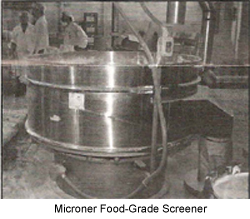 The VP Operations of this nutritional bar manufacturer called John Frederick of 1-2/BPST the week before Thanksgiving, needing to acquire food-grade custom designed Screeners in time For his plant shut down during the Christmas Holidays.
The VP Operations of this nutritional bar manufacturer called John Frederick of 1-2/BPST the week before Thanksgiving, needing to acquire food-grade custom designed Screeners in time For his plant shut down during the Christmas Holidays.
Microner Inc. manufactured the {41 foodgrade, high capacity, #4 polish Scalping Units and delivered them in lime. To meet high production rates, the units are designed with special screens that allow bag dumping of raw ingredients From both sides of the screener at the same time by two operators.
Also, to meet HACCP regulations, Bunting Magnetic's designed and supplied low headroom, high flow Rare Earth Grate Magnets to remove any ferrous contamination from raw materials. Bunting also supplied Magnetic Liquid Traps to ensure removal of any Ferrous metal From various liquid ingredients (chocolate etc.) used in the manufacture of the high-demand nutritional bars.
One of the ingredients in baby formula must have an average particle size of 1.4 microns. Mr. Len Glass, CEO of Micro-Tec contacted 1-2f8PST to evaluate the feasibility of the grinding process.
I-2/BPST installed a unique Super Fine "Vortex" Mill along with an Ingersoll-Rand Compressed Air System and custom Bulk Bag Dischargers with Feeders.
Mr. Glass says, "We chose the Vortex Mill because it is very simple, very easy to clean, has no moving parts and uses much less energy than any similar equipment we evaluated. The unique mill creates a "tornado" inside the unit and particles collide with each other to produce finer particles. It is like a magic box.
I·2f8PST engineered and installed this turn-key system in 3 months. I am very happy with the performance of the system."
